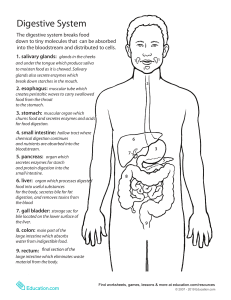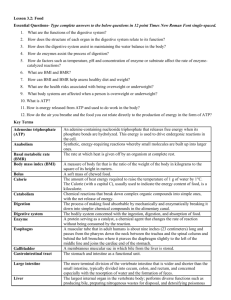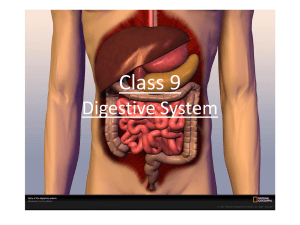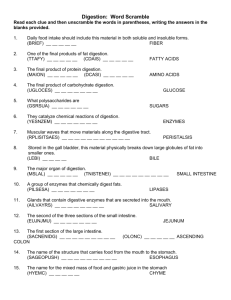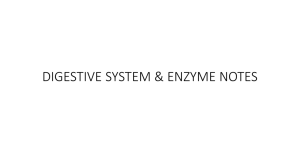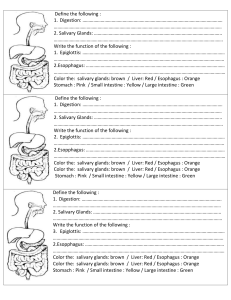L3.2.Food
advertisement
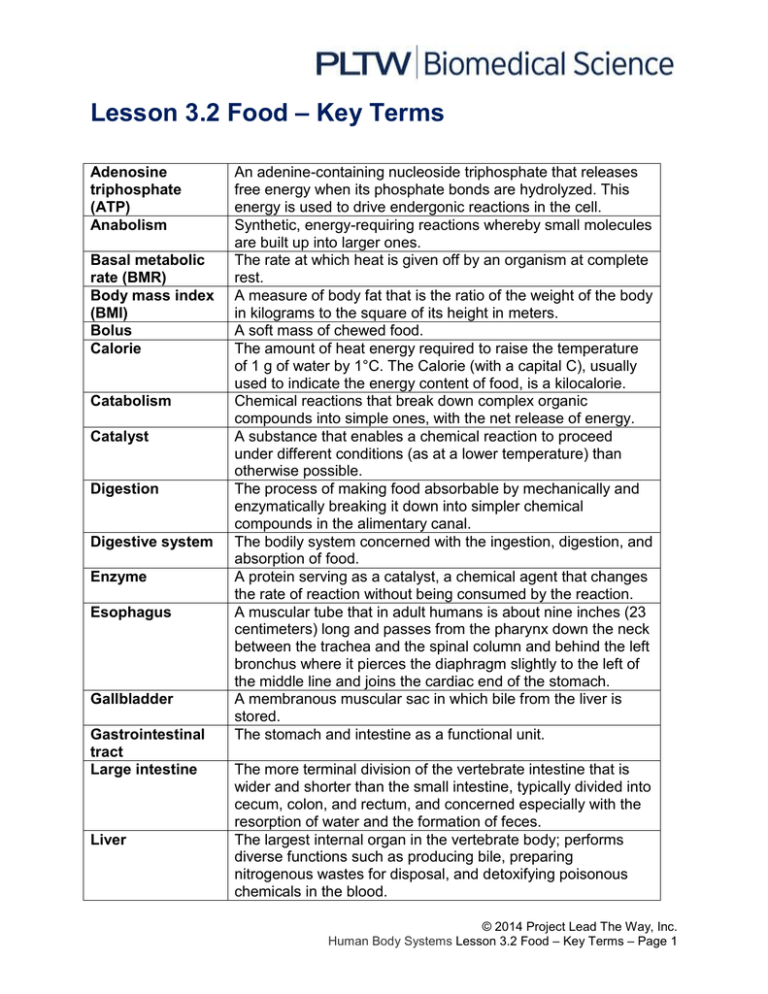
Lesson 3.2 Food – Key Terms Adenosine triphosphate (ATP) Anabolism Basal metabolic rate (BMR) Body mass index (BMI) Bolus Calorie Catabolism Catalyst Digestion Digestive system Enzyme Esophagus Gallbladder Gastrointestinal tract Large intestine Liver An adenine-containing nucleoside triphosphate that releases free energy when its phosphate bonds are hydrolyzed. This energy is used to drive endergonic reactions in the cell. Synthetic, energy-requiring reactions whereby small molecules are built up into larger ones. The rate at which heat is given off by an organism at complete rest. A measure of body fat that is the ratio of the weight of the body in kilograms to the square of its height in meters. A soft mass of chewed food. The amount of heat energy required to raise the temperature of 1 g of water by 1°C. The Calorie (with a capital C), usually used to indicate the energy content of food, is a kilocalorie. Chemical reactions that break down complex organic compounds into simple ones, with the net release of energy. A substance that enables a chemical reaction to proceed under different conditions (as at a lower temperature) than otherwise possible. The process of making food absorbable by mechanically and enzymatically breaking it down into simpler chemical compounds in the alimentary canal. The bodily system concerned with the ingestion, digestion, and absorption of food. A protein serving as a catalyst, a chemical agent that changes the rate of reaction without being consumed by the reaction. A muscular tube that in adult humans is about nine inches (23 centimeters) long and passes from the pharynx down the neck between the trachea and the spinal column and behind the left bronchus where it pierces the diaphragm slightly to the left of the middle line and joins the cardiac end of the stomach. A membranous muscular sac in which bile from the liver is stored. The stomach and intestine as a functional unit. The more terminal division of the vertebrate intestine that is wider and shorter than the small intestine, typically divided into cecum, colon, and rectum, and concerned especially with the resorption of water and the formation of feces. The largest internal organ in the vertebrate body; performs diverse functions such as producing bile, preparing nitrogenous wastes for disposal, and detoxifying poisonous chemicals in the blood. © 2014 Project Lead The Way, Inc. Human Body Systems Lesson 3.2 Food – Key Terms – Page 1 Metabolism Monomer Oral cavity Pancreas Peristalsis Pharynx Polymer Salivary amylase Salivary glands Small intestine Stomach Substrate The totality of an organism’s chemical reactions, consisting of catabolic and anabolic pathways. A molecule that can combine with others to form a polymer. The part of the mouth behind the gums and teeth that is bounded above by the hard and soft palates and below by the tongue and by the mucous membrane connecting it with the inner part of the mandible. A gland with dual functions: The nonendocrine portion secretes digestive enzymes and an alkaline solution into the small intestine via a duct; the endocrine portion secretes the hormones insulin and glucagon into the blood. Successive muscular contractions along the wall of a hollow muscular structure. An area in the vertebrate throat where air and food passages cross. A large molecule composed of repeating structural units or monomers. A salivary gland enzyme that hydrolyzes starch. Exocrine glands associated with the oral cavity. The secretions of salivary glands contain substances to lubricate food, adhere together chewed pieces into a bolus, and begin the process of chemical digestion. The part of the intestine that lies between the stomach and colon, consists of duodenum, jejunum, and ileum, secretes digestive enzymes, and is the chief site of the absorption of digested nutrients. A saclike expansion of the alimentary canal of a vertebrate communicating anteriorly with the esophagus and posteriorly with the duodenum and being typically a simple often curved sac with an outer serous coat, a strong complex muscular wall that contracts rhythmically, and a mucous lining membrane that contains gastric glands. A substance acted upon by an enzyme. © 2014 Project Lead The Way, Inc. Human Body Systems Lesson 3.2 Food – Key Terms – Page 2
